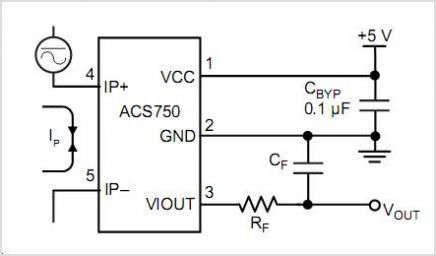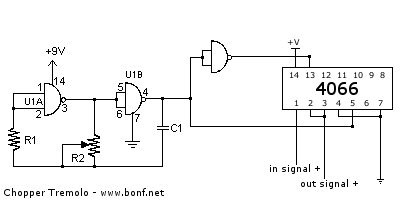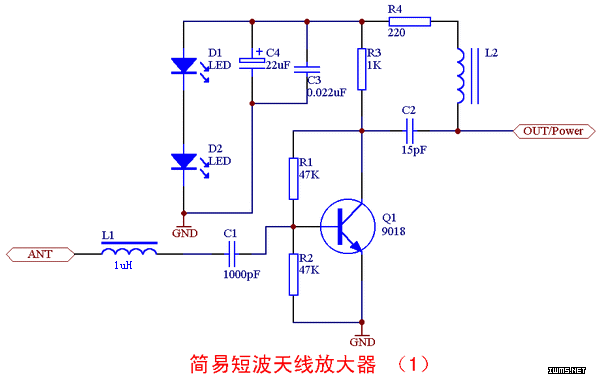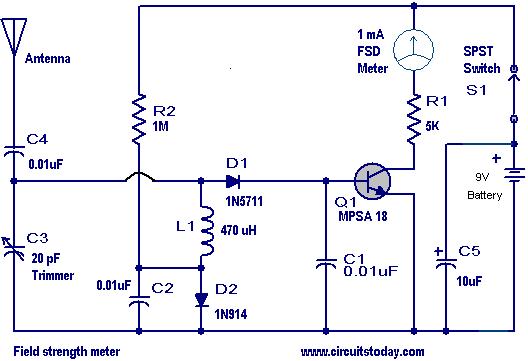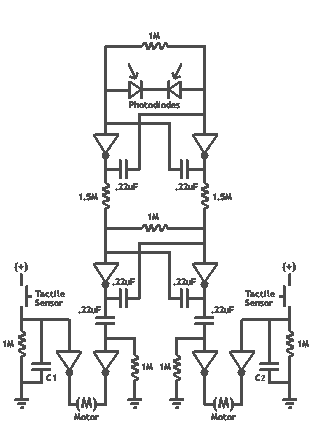
Hall Effect Sensors Magnetic Field
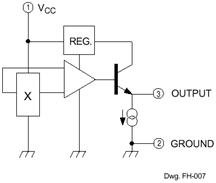
The Hall Effect sensor generates a voltage that is proportional to the strength of the magnetic field it detects. This sensor consists of a silicon layer with two electrodes on either side. In the absence of a magnetic field, the potential difference between the electrodes is 0 volts, as an electric current flows through the silicon layer. When a magnetic field influences the sensor, the current flow alters, causing a potential difference between the electrodes. This potential difference correlates with the strength of the magnetic field detected by the sensor. An example is the UGN3503U Hall Effect sensor, which produces a voltage proportional to the magnetic field strength it detects. The UGN3503U sensor features three pins and includes an integrated amplifier that enhances the signal from the sensor circuit, yielding an output voltage centered around the supply voltage. When exposed to a north pole magnetic field, the output voltage decreases, while exposure to a south pole magnetic field results in an increase in output voltage. This sensor can respond to both static and varying magnetic field strengths, with frequency variations up to 20 kHz. The UGN3503 Hall Effect sensor operates with a supply voltage range of 4.5V to 6V and can detect changes in magnetic field strength at frequencies up to 23 kHz. The core component of this system is the UGN3503U sensor, which produces a 3V output in the absence of a magnetic field. However, this output may not be strong enough, necessitating the use of an operational amplifier (op-amp) to further amplify the signal from the UGN3503U sensor.
The UGN3503U Hall Effect sensor is designed to measure magnetic fields with high precision and can be integrated into various electronic applications, including motor control, position sensing, and proximity detection. The sensor's construction, featuring a silicon layer, allows for effective interaction with magnetic fields, leading to reliable voltage outputs that can be easily processed by subsequent circuitry.
In practical applications, the sensor can be connected to a microcontroller or a digital signal processor (DSP) for further analysis and decision-making. The three pins of the UGN3503U typically serve as follows: one pin for the power supply, one for ground, and the third for the output voltage signal. The integrated amplifier within the sensor ensures that the output voltage is stable and centered around half of the supply voltage, facilitating easier interfacing with other electronic components.
When designing circuits that utilize the UGN3503U, it is important to consider the characteristics of the magnetic field being measured, including its strength and polarity. The output voltage response to different magnetic field polarities allows for versatile applications, such as distinguishing between the proximity of north and south magnetic poles.
In scenarios where the output signal requires further amplification, an op-amp can be used in a non-inverting configuration to boost the sensor's output. This configuration enhances the signal while maintaining the original phase, ensuring that the information regarding the magnetic field's strength and polarity is preserved.
Overall, the UGN3503U Hall Effect sensor is a valuable component in modern electronics, providing a reliable means of measuring magnetic fields across various applications.Hall Effect sensor will produce a voltage proportional to the magnetic field strength received by a Hall effect sensor tersebut. Sensor it only consists of a silicon layer and two electrodes on each side of the silicon. By the time without any influence of the magnetic field then the potential difference between the two electrodes is 0 Volt as an electric current flowing in the middle two electrodes.
When there is a magnetic field affecting the sensor is the current that flows will turn close to / away from the side that is affected by magnetic fields. This results in a potential difference between the two electrodes of Hall effect sensors, where the potential difference is proportional to the magnetic field received by the hall effect sensor.
One example is a sensor hall effect sensor UGN3503U. UGN3503U sensor will produce a voltage proportional to the strength of the magnetic field detected by the sensor UGN3503U. UGN3503 sensor has 3 pins, namely: In this sensor already built an amplifier that strengthens the signal from the sensor circuit and produce the output voltage in the middle of the supply voltage.
In this sensor if it gets the influence of magnetic field polarity of the north pole it would result in a reduction in the output voltage on the contrary, if there is the influence of magnetic field polarity of the south pole it will result in an increase in the output voltage. This sensor can respond to changes in magnetic field strength from a static magnetic field strength and the strength of the magnetic field varies with frequency up to 20kHz.
UGN3503 hall effect sensor has a wide supply voltage is from 4. 5V to 6V to the sensitivity of changes in magnetic field strength up to 23KHz frequency. The core of this system is the sensor UGN3503U. This sensor will produce output voltage 3V in the absence of magnetic field influence on the sensor. Tegagnan output is not strong enough so that it still needed an op amp is used to amplify the signal from the sensor changes UGN3503U. 🔗 External reference
The UGN3503U Hall Effect sensor is designed to measure magnetic fields with high precision and can be integrated into various electronic applications, including motor control, position sensing, and proximity detection. The sensor's construction, featuring a silicon layer, allows for effective interaction with magnetic fields, leading to reliable voltage outputs that can be easily processed by subsequent circuitry.
In practical applications, the sensor can be connected to a microcontroller or a digital signal processor (DSP) for further analysis and decision-making. The three pins of the UGN3503U typically serve as follows: one pin for the power supply, one for ground, and the third for the output voltage signal. The integrated amplifier within the sensor ensures that the output voltage is stable and centered around half of the supply voltage, facilitating easier interfacing with other electronic components.
When designing circuits that utilize the UGN3503U, it is important to consider the characteristics of the magnetic field being measured, including its strength and polarity. The output voltage response to different magnetic field polarities allows for versatile applications, such as distinguishing between the proximity of north and south magnetic poles.
In scenarios where the output signal requires further amplification, an op-amp can be used in a non-inverting configuration to boost the sensor's output. This configuration enhances the signal while maintaining the original phase, ensuring that the information regarding the magnetic field's strength and polarity is preserved.
Overall, the UGN3503U Hall Effect sensor is a valuable component in modern electronics, providing a reliable means of measuring magnetic fields across various applications.Hall Effect sensor will produce a voltage proportional to the magnetic field strength received by a Hall effect sensor tersebut. Sensor it only consists of a silicon layer and two electrodes on each side of the silicon. By the time without any influence of the magnetic field then the potential difference between the two electrodes is 0 Volt as an electric current flowing in the middle two electrodes.
When there is a magnetic field affecting the sensor is the current that flows will turn close to / away from the side that is affected by magnetic fields. This results in a potential difference between the two electrodes of Hall effect sensors, where the potential difference is proportional to the magnetic field received by the hall effect sensor.
One example is a sensor hall effect sensor UGN3503U. UGN3503U sensor will produce a voltage proportional to the strength of the magnetic field detected by the sensor UGN3503U. UGN3503 sensor has 3 pins, namely: In this sensor already built an amplifier that strengthens the signal from the sensor circuit and produce the output voltage in the middle of the supply voltage.
In this sensor if it gets the influence of magnetic field polarity of the north pole it would result in a reduction in the output voltage on the contrary, if there is the influence of magnetic field polarity of the south pole it will result in an increase in the output voltage. This sensor can respond to changes in magnetic field strength from a static magnetic field strength and the strength of the magnetic field varies with frequency up to 20kHz.
UGN3503 hall effect sensor has a wide supply voltage is from 4. 5V to 6V to the sensitivity of changes in magnetic field strength up to 23KHz frequency. The core of this system is the sensor UGN3503U. This sensor will produce output voltage 3V in the absence of magnetic field influence on the sensor. Tegagnan output is not strong enough so that it still needed an op amp is used to amplify the signal from the sensor changes UGN3503U. 🔗 External reference
